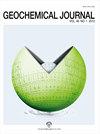日本北海道Horonobe地区新近系沉积地层孔隙水演化:埋藏成岩作用模拟
IF 1.6
4区 地球科学
Q3 GEOCHEMISTRY & GEOPHYSICS
引用次数: 0
摘要
在高放废物地质处置中,低地下水流量是阻碍放射性核素迁移的关键。在厚厚的海洋沉积物的深层地下,地下水实际上可能是在沉积和埋藏过程中改变的古海水,本研究称之为“化石海水”。在这种情况下,地下水流动极其缓慢,因为它不受大气水渗透的影响,即使在地层隆起和侵蚀之后也是如此。在日本北海道北部Horonobe天保古盆地新近系海相沉积Koetoi组和Wakkanai组的较深处,经常发现化石海水。使用Cl同位素和He浓度的地下水年代测定表明,自该地区开始隆起以来,这些化石海水可能几乎没有移动过。为了确认化石海水的低流量性质,通过数值模拟研究了Horonobe地区化石海水的化学性质和埋藏成岩作用,重点研究了生物成因二氧化硅相变引起的脱水作用、蒙脱石层间水脱水作用以及孔隙减少导致的排水和上涌作用。结果表明,埋藏过程中可形成δ18O值>0‰、δ2H值为- 30‰~ - 20‰、Cl−浓度低于海水浓度≤80%的地下水,而不与大气降水混合。因此,在Koetoi组和Wakkanai组的深层埋藏过程中形成的地下水可能自隆起以来一直被保存下来,这证实了化石海水的流动性极低。研究结果将有助于了解海洋沉积物孔隙水的稀释机理和高放射性废物地质处置场地的选择。本文章由计算机程序翻译,如有差异,请以英文原文为准。
Evolution of porewater in a Neogene sedimentary formation in the Horonobe area, Hokkaido, Japan: Modeling of burial diagenesis
Low groundwater flow is essential in impeding radionuclide migration in the geological disposal of high-level radioactive waste (HLW). In the deep subsurface of thick marine sediments, groundwater may actually be ancient seawater altered during deposition and burial, termed “fossil seawater” in this study. In such cases, groundwater flow is extremely slow because it is not affected by infiltration of meteoric water, even after uplift and erosion of strata. Fossil seawater is often found in the deeper parts of the Neogene marine sedimentary Koetoi and Wakkanai Formations of the Tempoku Basin, Horonobe, northern Hokkaido, Japan. Groundwater dating using Cl isotopes and He concentration indicates that this fossil seawater may have barely moved since uplift of the area began. To confirm the low-flow nature of fossil seawater, its chemistry in the Horonobe area and burial diagenesis were investigated by numerical modeling, focusing on the effects of dehydration associated with phase transitions of biogenic silica, smectite interlayer water dehydration, and drainage and upwelling through porosity reduction. Results indicate that groundwater with δ18O values of >0‰, δ2H values of −30‰ to −20‰, and Cl− concentrations of ≤80% lower than that of seawater can be formed during burial without mixing with meteoric water. Groundwater formed during burial in the deeper parts of the Koetoi and Wakkanai Formations may thus have been preserved since uplift, confirming that fossil seawater is of extremely low mobility. The results should contribute to understanding the dilution mechanism of porewater in marine sediments and the selection of suitable site for geological disposal of high-level radioactive waste.
求助全文
通过发布文献求助,成功后即可免费获取论文全文。
去求助
来源期刊

Geochemical Journal
地学-地球化学与地球物理
CiteScore
1.70
自引率
12.50%
发文量
11
审稿时长
6 months
期刊介绍:
Geochemical Journal is an international journal devoted to original research papers in geochemistry and cosmochemistry. It is the primary journal of the Geochemical Society of Japan. Areas of research are as follows:
Cosmochemistry; Mineral and Rock Chemistry; Volcanology and Hydrothermal Chemistry; Isotope Geochemistry and Geochronology; Atmospheric Chemistry; Hydro- and Marine Chemistry; Organic Geochemistry; Environmental Chemistry.
 求助内容:
求助内容: 应助结果提醒方式:
应助结果提醒方式:


